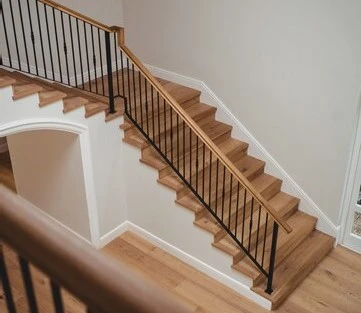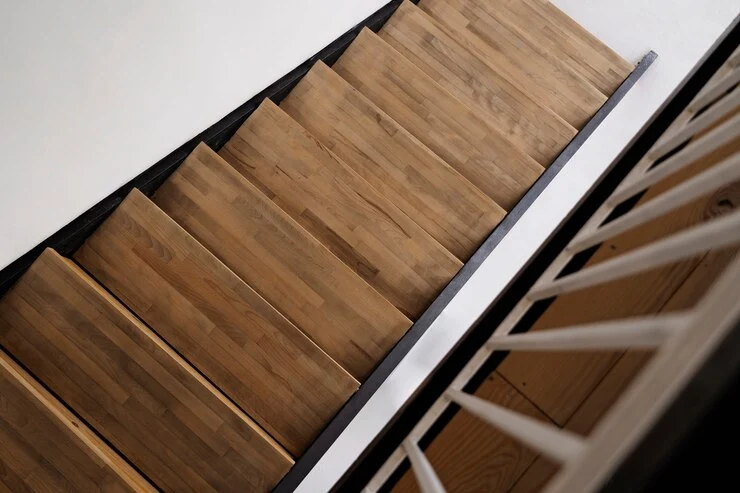When it comes to enhancing your home’s aesthetic, board and batten stairs offer a timeless charm that blends style and functionality. This versatile design has become popular in recent years. It’s a favorite among homeowners and designers. Whether planning a renovation or adding elegance, this guide covers board and batten stairs.
What Are Board and Batten Stairs?
Board and batten is a classic architectural style that involves vertical panels (boards) separated by narrower strips (battens). When applied to stairs, this technique creates a visually appealing look that adds texture and depth. Typically used on walls, this design can transform staircases into stunning focal points.
The concept comes from traditional barn and farmhouse architecture. It combines rustic appeal with modern simplicity. Today, board and batten is not just for exterior walls. It’s popular in interior design for its versatility and appeal.
Why Choose Board and Batten for Your Stairs?
Timeless Aesthetic Appeal
Board and batten design offers rustic yet refined charm. Its clean lines and simple structure suit many interior styles.
It works with farmhouse or modern minimalism themes. Whether your home is vintage or contemporary, board and batten stairs fit seamlessly.
Increased Home Value
Investing in aesthetic upgrades like board and batten stairs can boost your home’s resale value. Buyers appreciate unique features that make a house stand out. A staircase with board and batten detailing can be an eye-catching element that leaves a lasting impression.
Durability and Maintenance
Board and batten materials are durable and low-maintenance. They can handle daily wear, making them perfect for high-traffic areas like staircases.
Unlike plain painted walls, the battens’ extra dimension hides scuffs and dents, keeping your stairs looking clean.
Customization Opportunities
Board and batten stairs offer endless customization options, from materials to paint colors. This flexibility lets homeowners create a look that reflects their style and personality.
Materials Needed for Board and Batten Stairs
To achieve the perfect look, you’ll need the right materials. Here’s a detailed breakdown:
- Boards: These are the larger panels, often made from wood, MDF, or PVC. Choose good quality materials for lasting durability.
- Battens: Narrow strips of wood or similar material used to cover the seams. Choose battens of uniform size for a cohesive design.
- Paint or Stain: Choose colors or finishes that match your home’s interior. Neutral tones like white, beige, and gray are popular choices, but bold hues can make a statement.
- Fasteners: Nails, screws, or adhesive for securing the panels and battens. Ensure they are appropriate for your chosen materials.
- Tools: Measuring tape, saw, level, hammer, caulk gun, and paintbrushes. A miter saw can be particularly useful for precise cuts.
Step-by-Step Guide to Installing Board and Batten Stairs
Step 1. Plan Your Design
Start by sketching out your board and batten layout. Decide on the spacing, width, and height of the panels to ensure symmetry. Factor in the staircase dimensions and the overall look you want to achieve. You may also want to consult with a design professional for complex layouts.
Step 2. Gather Materials and Tools
Once you’ve finalized your design, collect all the necessary materials and tools. Double-check measurements to avoid costly mistakes. Consider pre-primed boards and battens to save time during the painting process.
Step 3. Prepare the Staircase
Remove any existing trim or carpeting. Sand down uneven surfaces and clean the area to ensure proper adhesion of the boards and battens. A clean, smooth surface is critical for a professional finish. If your stairs have existing imperfections, patch them up before proceeding.
Step 4. Install the Boards
Measure and cut the larger panels to fit the risers and sides of the staircase. Secure them using nails or adhesive. Be precise with your measurements to avoid gaps or uneven edges. Use a level to make sure the boards are straight. Take your time with this step for a professional finish.
Step 5. Attach the Battens
Position the battens evenly along the boards and secure them. Use a level to ensure straight alignment. Battens should be spaced consistently to maintain symmetry and aesthetic balance. For beginners, using a spacer tool can make this step much easier.
Step 6. Caulk and Fill Gaps
Apply caulk to seams and gaps for a seamless look. Use wood filler to cover any nail holes or flaws. This step is essential for a polished and professional appearance. Let the filler dry completely before proceeding.
Step 7. Paint or Stain
Apply a coat of paint or stain to achieve your desired finish. Allow sufficient drying time between coats for a smooth appearance. Satin or semi-gloss finishes work best for stairs, as they’re durable and easy to clean.

Design Ideas for Board and Batten Stairs
Classic White Elegance
White board and batten stairs exude simplicity and sophistication. Combine them with dark wood treads for a bold contrast. This timeless design is perfect for brightening small or dimly lit spaces.
Two-Tone Contrast
Combine two colors, such as navy and white, to create a bold and modern look. This approach adds visual interest and works well in contemporary settings.
Rustic Charm
If you love farmhouse aesthetics, use unfinished wood or wood with a distressed finish for your battens. Pair it with metal accents for a complete rustic vibe. This design is perfect for those looking to add character to their home.
Geometric Patterns
Experiment with unique batten arrangements, such as diagonal or herringbone patterns, to add a creative touch. These designs can make a dramatic statement while showcasing your personal style.
Vertical and Horizontal Mix
Incorporate horizontal battens alongside vertical ones for a dynamic, layered effect. This hybrid approach can create depth and dimension, especially in larger staircases.
Tips for DIY Success
- Measure Twice, Cut Once: Getting the measurements right is key to a successful project.
- Invest in Quality Tools: Using the right tools can save time and ensure professional results.
- Start Small: If you’re new to DIY projects, begin with a small staircase or a single section.
- Practice Painting: Test your painting technique on scrap wood before applying it to the staircase.
- Be Patient: Rushing through steps can lead to mistakes. Don’t rush for the best outcome.
Maintenance Tips for Board and Batten Stairs
Regular Cleaning
Dust and wipe the panels regularly to keep them looking fresh. Use a damp cloth for deeper cleaning, but avoid harsh chemicals that could damage the finish.
Touch-Up Paint
Over time, small nicks and scratches may appear. Keep extra paint or stain available for easy touch-ups. Regular maintenance will ensure your stairs remain in pristine condition.
Inspect for Damage
Regularly check for loose panels or battens and fix them quickly to keep the design intact. Tighten fasteners as needed to prevent further wear.
Common Mistakes to Avoid
Skipping Measurements
Precise measurements are crucial for a symmetrical and polished look. Rushing through this step can result in uneven spacing and an unprofessional finish.
Using Low-Quality Materials
Choose strong materials to make sure they last longer and need less upkeep. Low-quality boards and battens may warp or deteriorate over time.
Overcomplicating the Design
While creative patterns can be stunning, overly complex designs may overwhelm the space. Stick to a layout that complements the overall style of your home.
Ignoring Preparation
Failing to prepare the staircase surface can lead to poor adhesion and a subpar finish. Take the time to clean, sand, and prime the area before installation.
FAQs
What wood is used for board and batten?
The most commonly used wood for board and batten is pine, MDF (medium-density fiberboard), or cedar. These materials are durable, cost-effective, and easy to work with, making them suitable for DIY projects.
Can I use plywood for board and batten?
Yes, plywood is a budget-friendly option for board and batten. When painted or stained properly, it can provide a clean and professional look. Ensure the edges are smooth for the best results.
What size is board and batten material?
Board sizes typically range between 1/4 inch to 1/2 inch in thickness and are cut to fit the dimensions of your staircase. Battens are usually 1 to 2 inches wide, but their size can be adjusted based on your design preference.
What timber is best for battens?
For battens, hardwoods like oak or maple are excellent for durability, while softwoods like pine are more affordable and easier to handle for DIY enthusiasts. Choose timber that matches your overall design and budget.
What height should board and batten be on stairs?
Board and batten height on stairs typically ranges from 36 to 48 inches, depending on the ceiling height and overall design. For a balanced look, align the top of the board and batten with the height of adjacent railings or wainscoting.
How do I design a board and batten entryway with stairs?
To create a cohesive look, extend the board and batten design from your entryway to the staircase wall. Use complementary colors and materials to tie the two spaces together. Add hooks or a small shelf to the entryway for added functionality.
Conclusion
Board and batten stairs are more than just a design trend, they’re a timeless feature that adds character and value to your home. With their versatility and elegance, they’re an excellent choice for anyone looking to make a statement. Whether you’re a seasoned DIY enthusiast or hiring a professional, this design promises to transform your staircase into a stunning focal point. By following this guide, you can bring your vision to life and create a space that is both functional and visually captivating.
